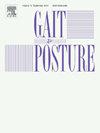The relationship between fear of movement and ankle biomechanical strategies in a 180° change of direction task
IF 2.2
3区 医学
Q3 NEUROSCIENCES
引用次数: 0
Abstract
Objective
To assess the association between fear of movement and ankle biomechanics and timed performance in a 505 agility change of direction (COD) test, and to assess the association between the biomechanical indices with timed performance.
Methods
Twenty participants, who play football at a university level or higher, with a history of ankle injuries were recruited. All participants performed three maximal effort 505 agility COD tests. Three-dimensional ankle range of motion (ROM, measured using inertial measurement units) and the average ankle muscle co-activation (tibialis anterior, soleus, and peroneus longus muscles of the affected limb, measured using bipolar surface electromyography) were extracted from the stance phase of the final cutting step. Fear of movement was assessed using the Tampa Scale of Kinesiophobia 11-item (TSK-11) questionnaire.
Results
TSK-11 significantly correlated with ankle transverse plane ROM: r = -0.53 (95 %CI −0.79 to −0.11), t = -2.63, P = 0.017. There was no significant association between the COD timed performance and the four ankle biomechanical indices.
Conclusions
Greater fear of movement may result in a stiffer turning strategy, which may reduce the risk of injury to the ankle. However, fear of movement is less likely to moderate ankle kinematic and muscle activation strategies that give rise to a performance-injury conflict.
求助全文
约1分钟内获得全文
求助全文
来源期刊

Gait & posture
医学-神经科学
CiteScore
4.70
自引率
12.50%
发文量
616
审稿时长
6 months
期刊介绍:
Gait & Posture is a vehicle for the publication of up-to-date basic and clinical research on all aspects of locomotion and balance.
The topics covered include: Techniques for the measurement of gait and posture, and the standardization of results presentation; Studies of normal and pathological gait; Treatment of gait and postural abnormalities; Biomechanical and theoretical approaches to gait and posture; Mathematical models of joint and muscle mechanics; Neurological and musculoskeletal function in gait and posture; The evolution of upright posture and bipedal locomotion; Adaptations of carrying loads, walking on uneven surfaces, climbing stairs etc; spinal biomechanics only if they are directly related to gait and/or posture and are of general interest to our readers; The effect of aging and development on gait and posture; Psychological and cultural aspects of gait; Patient education.
 求助内容:
求助内容: 应助结果提醒方式:
应助结果提醒方式:


